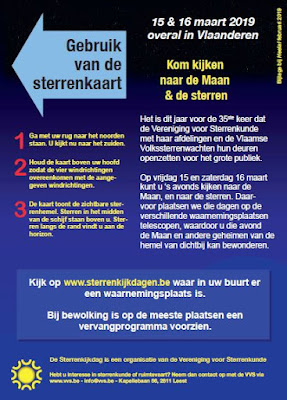Clear sky with -0,5°C and the Moon, Saturn and Jupiter in the morning sky.
Pascal Hilkens Astro Home Page
Friday, March 29, 2019
Sunday, March 10, 2019
Final C/2018 Y1 Iwamoto with M36 & M38
Not really pleased with the results of my Iwamoto pictures, I started to do something different. In stead of taking the ISO 3200 or ISO 6400, I took the ISO 1600 pictures.The Nikon Raw was converted to DNG and editing with CS4. Unsharped Mask was used but this time the threshold is increased. The pictures looks more sharp with the comet still bright enough to distinguish from the background stars. The open star clusters M36 and M38 are easy to recognize.
Saturday, March 9, 2019
C/2018 Y1 Iwamoto near M36 & M38
Comet C/2018 Y1 Iwamoto near open star cluster M36 and M38. Picture taken on Feb 27, 2019 with Nikon D7500 on TLAPO80/480 f/6 and setting ISO6400 for 30s. DNG file and dark used for editing with CS4.
Iwamoto - My first animated GIF
My first animated GIF file :) and showing how "fast" Iwamoto is moving in front of the stars. Two pictures taken on Feb 26, 2019 UT20h15 and UT20h22. The GIF file shows in those 7 minutes how the comet C/2018 Y1 Iwamoto moves against the background stars. Each picture was taken with Nikon D7500 on TLAPO 80/480 f/6 ISO6400 with 30s exposure time. The GIF file was made using CS4 (Animation - Gif). DNG files are used without editing.
Solar Tadpole Shaped Jets responable for heating up the Corona?
 |
Images from IRIS show the tadpole-shaped jets containing pseudo-shocks streaking out from the Sun.
Credits: Abhishek Srivastava IIT (BHU)/Joy Ng, NASA’s Goddard Space Flight Center
|
When recently analyzing data from NASA’s Interface Region Imaging Spectrograph, or IRIS, scientists noticed unique elongated jets emerging from sunspots and rising 4,500 km up into the inner corona. The jets, with bulky heads and rarefied tails, looked to the scientists like tadpoles swimming up through the Sun’s layers.
Using computer simulations matching the events, they determined these pseudo-shocks could carry enough energy and plasma to heat the inner corona.
ESA Lagrange Mission
ESA is planning for a dedicated space weather observatory which warns us in case of these harmful eruptions of the Sun. The new spacecraft will operate at the fifth Lagrange point at a distance of 150 million km. On this stable position in space the spacecraft is able to observe the Sun and Earth sideways.
Tuesday, March 5, 2019
Sterrenkijkdagen op 15 en 16 maart
Subscribe to:
Comments (Atom)










